towing LINCOLN MKT 2016 Owners Manual
[x] Cancel search | Manufacturer: LINCOLN, Model Year: 2016, Model line: MKT, Model: LINCOLN MKT 2016Pages: 452, PDF Size: 4.69 MB
Page 7 of 452

Luggage Covers...........................................234
Load Limit.......................................................235
Towing
Towing a Trailer.............................................243
Trailer Sway Control....................................244
Recommended Towing Weights...............244
Essential Towing Checks ............................
246
Transporting the Vehicle............................249
Towing the Vehicle on Four Wheels - 2.0L EcoBoost™..................................................250
Towing the Vehicle on Four Wheels - 3.5L Ecoboost™/3.7L..........................................251
Driving Hints
Breaking-In.....................................................253
Economical Driving
......................................253
Driving Through Water
...............................253
Floor Mats
......................................................254
Roadside Emergencies
Roadside Assistance
...................................256
Hazard Warning Flashers...........................257 Fuel Shutoff....................................................257
Jump Starting the Vehicle
..........................258
Customer Assistance
Getting the Services You Need.................261
In California (U.S. Only)...............................262
The Better Business Bureau (BBB) Auto Line Program (U.S. Only)........................263
Utilizing the Mediation/Arbitration Program (Canada Only)...........................................264
Getting Assistance Outside the U.S. and Canada
.......................................................265
Ordering Additional Owner's Literature....................................................266
Reporting Safety Defects (U.S. Only).......267
Reporting Safety Defects (Canada Only)............................................................267
Fuses
Fuse Specification Chart
............................269
Changing a Fuse..........................................285
Maintenance
General Information
.....................................286 Opening and Closing the Hood...............287
Under Hood Overview - 2.0L
EcoBoost™..................................................288
Under Hood Overview - 3.5L Ecoboost™..................................................290
Under Hood Overview - 3.7L....................292
Engine Oil Dipstick - 2.0L EcoBoost™......294
Engine Oil Dipstick - 3.5L Ecoboost™/ 3.7L..............................................................294
Engine Oil Check.........................................294
Oil Change Indicator Reset.......................295
Engine Coolant Check
................................296
Automatic Transmission Fluid Check - 2.0L EcoBoost™..................................................300
Automatic Transmission Fluid Check - 3.5L Ecoboost™/3.7L.........................................300
Brake Fluid Check.......................................302
Power Steering Fluid Check
......................303
Washer Fluid Check....................................303
Changing the 12V Battery
..........................303
Checking the Wiper Blades.......................305
Changing the Wiper Blades......................305
Adjusting the Headlamps
..........................306
Removing a Headlamp...............................307
4
MKT (), enUSA, First Printing Table of Contents
Page 44 of 452
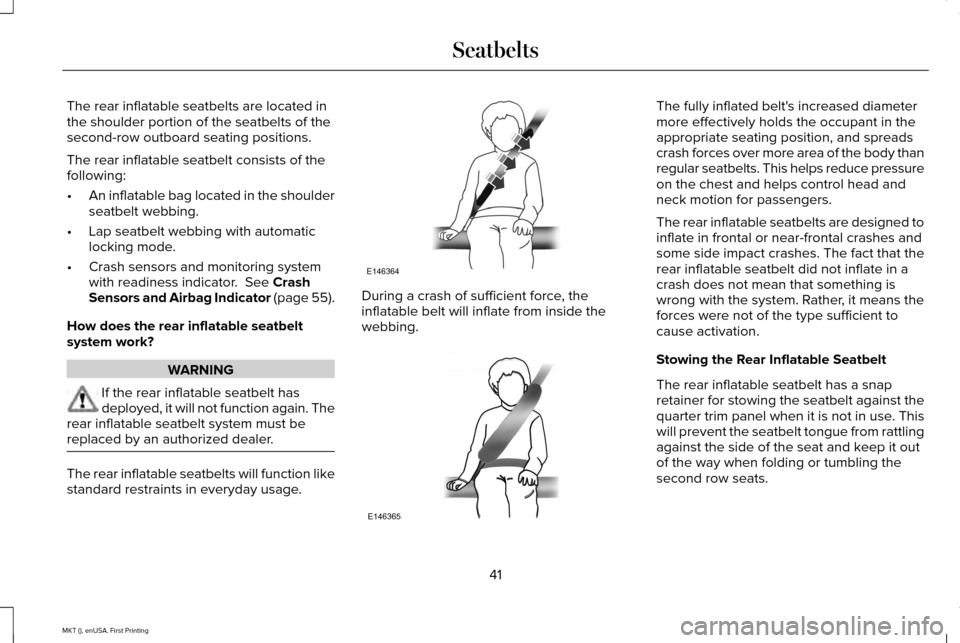
The rear inflatable seatbelts are located in
the shoulder portion of the seatbelts of the
second-row outboard seating positions.
The rear inflatable seatbelt consists of the
following:
•
An inflatable bag located in the shoulder
seatbelt webbing.
• Lap seatbelt webbing with automatic
locking mode.
• Crash sensors and monitoring system
with readiness indicator. See Crash
Sensors and Airbag Indicator (page 55).
How does the rear inflatable seatbelt
system work? WARNING
If the rear inflatable seatbelt has
deployed, it will not function again. The
rear inflatable seatbelt system must be
replaced by an authorized dealer. The rear inflatable seatbelts will function like
standard restraints in everyday usage. During a crash of sufficient force, the
inflatable belt will inflate from inside the
webbing. The fully inflated belt's increased diameter
more effectively holds the occupant in the
appropriate seating position, and spreads
crash forces over more area of the body than
regular seatbelts. This helps reduce pressure
on the chest and helps control head and
neck motion for passengers.
The rear inflatable seatbelts are designed to
inflate in frontal or near-frontal crashes and
some side impact crashes. The fact that the
rear inflatable seatbelt did not inflate in a
crash does not mean that something is
wrong with the system. Rather, it means the
forces were not of the type sufficient to
cause activation.
Stowing the Rear Inflatable Seatbelt
The rear inflatable seatbelt has a snap
retainer for stowing the seatbelt against the
quarter trim panel when it is not in use. This
will prevent the seatbelt tongue from rattling
against the side of the seat and keep it out
of the way when folding or tumbling the
second row seats.
41
MKT (), enUSA, First Printing SeatbeltsE146364 E146365
Page 116 of 452
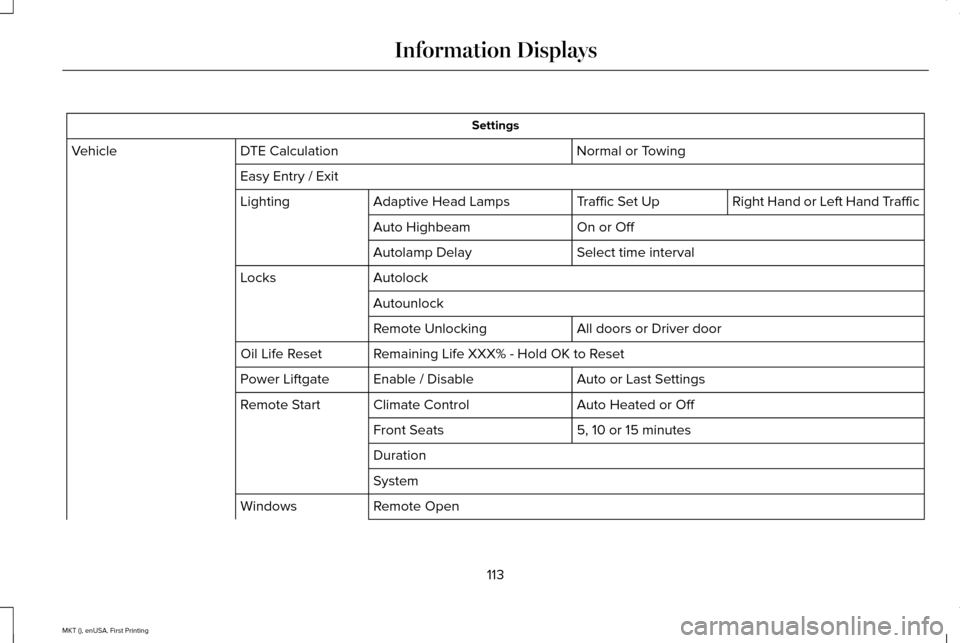
Settings
Normal or Towing
DTE Calculation
Vehicle
Easy Entry / Exit Right Hand or Left Hand Traffic
Traffic Set Up
Adaptive Head Lamps
Lighting
On or Off
Auto Highbeam
Select time interval
Autolamp Delay
Autolock
Locks
Autounlock All doors or Driver door
Remote Unlocking
Remaining Life XXX% - Hold OK to Reset
Oil Life Reset
Auto or Last Settings
Enable / Disable
Power Liftgate
Auto Heated or Off
Climate Control
Remote Start
5, 10 or 15 minutes
Front Seats
Duration
System
Remote Open
Windows
113
MKT (), enUSA, First Printing Information Displays
Page 147 of 452

1. Pull on the strap located on the back of
the second row seat. This will fold the
seatback forward. Pull the strap a second
time to tumble the seat forward, allowing
easy exit from the third row seat. Note:
The seatback must be folded flat in order
to release the floor latches. Make sure
that there are no objects on the seat
cushion that may restrict the seatback
from folding flat. 2. To return the seatback to the floor from
the tumbled position, rotate the seat
down until you hear it latching to the
floor. 3. Lift the seatback toward the rear of the
vehicle, and rotate the seatback until you
hear a click, locking it in the upright
position.
Note: The seatback will not
raise if the rear latch hooks are not
properly engaged to the floor striker. If
the seatback does not raise, then repeat
steps 3 and 4. 4. Make sure that the rear latch hooks are
properly engaged with the floor striker.
Note: Make sure that the seat and seatback
are latched securely in position. Keep floor
area free of objects that would prevent
proper seat engagement.
Stowing the Third Row Seat
Note: Remove all objects from the seat and
stowage tub. Objects in the seat or stowage
tub may cause serious damage to the seat
upholstery and cause improper seat function.
144
MKT (), enUSA, First Printing SeatsE190850 E209849 E190847
Page 148 of 452
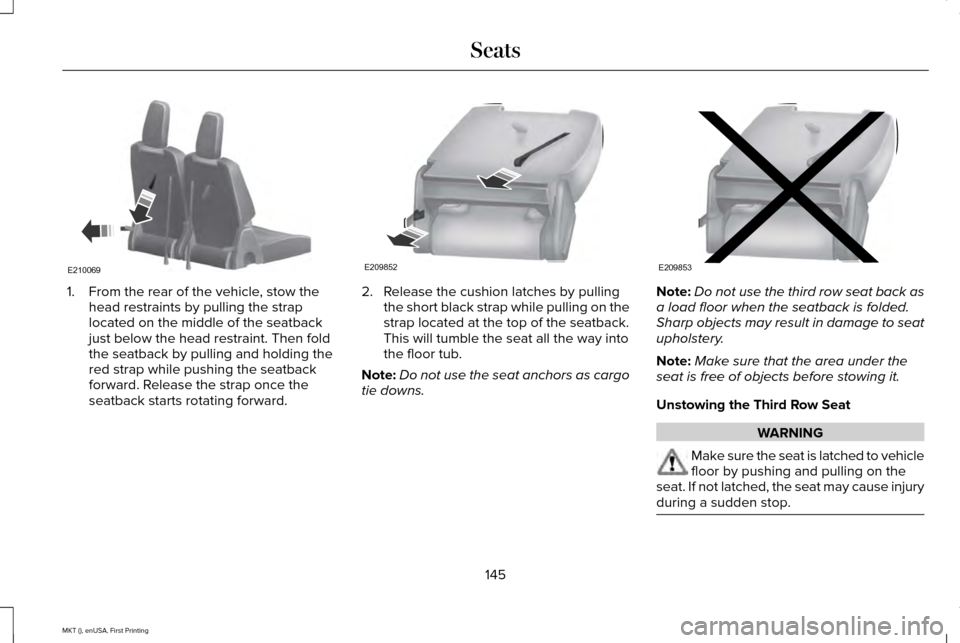
1. From the rear of the vehicle, stow the
head restraints by pulling the strap
located on the middle of the seatback
just below the head restraint. Then fold
the seatback by pulling and holding the
red strap while pushing the seatback
forward. Release the strap once the
seatback starts rotating forward. 2. Release the cushion latches by pulling
the short black strap while pulling on the
strap located at the top of the seatback.
This will tumble the seat all the way into
the floor tub.
Note: Do not use the seat anchors as cargo
tie downs. Note:
Do not use the third row seat back as
a load floor when the seatback is folded.
Sharp objects may result in damage to seat
upholstery.
Note: Make sure that the area under the
seat is free of objects before stowing it.
Unstowing the Third Row Seat WARNING
Make sure the seat is latched to vehicle
floor by pushing and pulling on the
seat. If not latched, the seat may cause injury
during a sudden stop. 145
MKT (), enUSA, First Printing SeatsE210069 E209852 E209853
Page 149 of 452

Note:
Make sure that there are no objects
such as books, purses or brief cases on the
load floor before unstowing the seat. Failure
to remove all objects from the top of the load
floor prior to unstowing it may cause
damage to the seat.
Note: Make sure the area under the forward
portion of the load floor is free of objects
before unstowing the third row seat. 1. Unlatch and lift the seat out of the floor
tub by squeezing and pulling up on the
handle. Once the seat is at a vertical
position, push the seat over, letting it fall
onto the latches. 2. To return the seatback to the upright
position, pull the red strap. Then, while
holding the red strap, pull the long strap
located on the seatback to raise the
seatback.
3. Pull the head restraints up to their normal
positions. PowerFold™Third Row Seats (If equipped)
The third row seat features a power
one-touch operation that allows you to adjust
the left, right, or both seats into a NORMAL,
STOW, FOLD, or TAILGATE position with just
one touch of a button.
Note:
The power fold seats work only when
the transmission is in park (P) and the
tailgate is open. If the ignition is off and the
feature is still running, the battery saver will
turn it off after 10 minutes. You can
reactivate the power seats by pressing the
unlock button on the remote entry key fob
or by using the unlock procedure on the
keyless entry keypad. See Keyless Entry
(page 76). Keep the key in the accessory or
run position to prevent the feature from
timing out.
The third row power seat buttons are located
behind the third row seats on the left-hand
quarter trim panel.
146
MKT (), enUSA, First Printing SeatsE209854 E209852
Page 151 of 452

Note:
Pressing a different button while the
power seat feature is already being
performed may cause the first selected seat
movement to be cancelled. Allow the first
seat movement to be completed before
pressing a button for another function.
Note: Make sure that there are no objects
such as books, purses or briefcases on the
load floor before unstowing the seat. Failure
to remove all objects from the top of the load
floor prior to unstowing it may cause
damage to the seat.
Note: In order to allow the seat to complete
the stowed position, do not place objects
under the seat before stowing. Remove all
objects from the seat and stowage tub.
Note: In the unlikely event that the third row
power seat stops prematurely or travels to
an unexpected position, press the FOLD
button (C) to reset the seat and return it to
a normal position. WARNING
Do not drive the vehicle when the third
row seat is rotated backwards. During
a sudden stop, the seatbelts are not
functional in this position and the third row
seat can rapidly tip back to the forward
position, all of which may result in serious
injury. HEATED SEATS (If Equipped)
Front Seats WARNING
People who are unable to feel pain to
their skin because of advanced age,
chronic illness, diabetes, spinal cord injury,
medication, alcohol use, exhaustion or other
physical conditions, must exercise care when
using the heated seat. The heated seat may
cause burns even at low temperatures,
especially if used for long periods of time.
Do not place anything on the seat that
insulates against heat, such as a blanket or
cushion. This may cause the heated seat to
overheat. Do not puncture the seat with pins,
needles or other pointed objects. This may
damage the heating element which may
cause the heated seat to overheat. An
overheated seat may cause serious personal
injury. 148
MKT (), enUSA, First Printing SeatsE209856
Page 181 of 452

SelectShift Automatic
™ Transmission (If
Equipped)
Your vehicle is equipped with a SelectShift
Automatic transmission. The SelectShift
Automatic transmission gives you the ability
to change gears up or down (without a
clutch) as desired.
In order to prevent the engine from running
at too low an RPM, which may cause it to
stall, SelectShift still automatically makes
some downshifts if it has determined that
you have not downshifted in time. Although
SelectShift makes some downshifts for you,
it still allows you to downshift at any time as
long as the SelectShift determines that
damage will not be caused to the engine
from over-revving.
Note: Engine damage may occur if you
maintain excessive engine revving without
shifting. SelectShift does not automatically upshift,
even if the engine is approaching the RPM
limit. It must be shifted manually by pressing
the + button. Notice should be taken of the
shift indicator lamp, which alerts you when
to shift to make sure you achieve the highest
level or efficiency and fuel economy.
If equipped with the toggle on the gearshift
lever, press the + toggle switch on the side
of the gearshift lever to activate SelectShift.
•
Press the (+) button to upshift.
• Press the (-) button to downshift. If equipped with steering wheel paddles,
pull the + paddle on the steering wheel to
activate SelectShift.
•
Pull the right paddle (+) to upshift.
• Pull the left paddle (–) to downshift. SelectShift in drive (D):
•
Provides a temporary manual mode for
performing more demanding maneuvers
where extra control of gear selection is
required (for example, when towing or
overtaking). This mode will hold a
selected gear for a temporary period of
time dependent on driver inputs (for
example, steering or accelerator pedal
input).
178
MKT (), enUSA, First Printing TransmissionE142629 E144821
Page 207 of 452
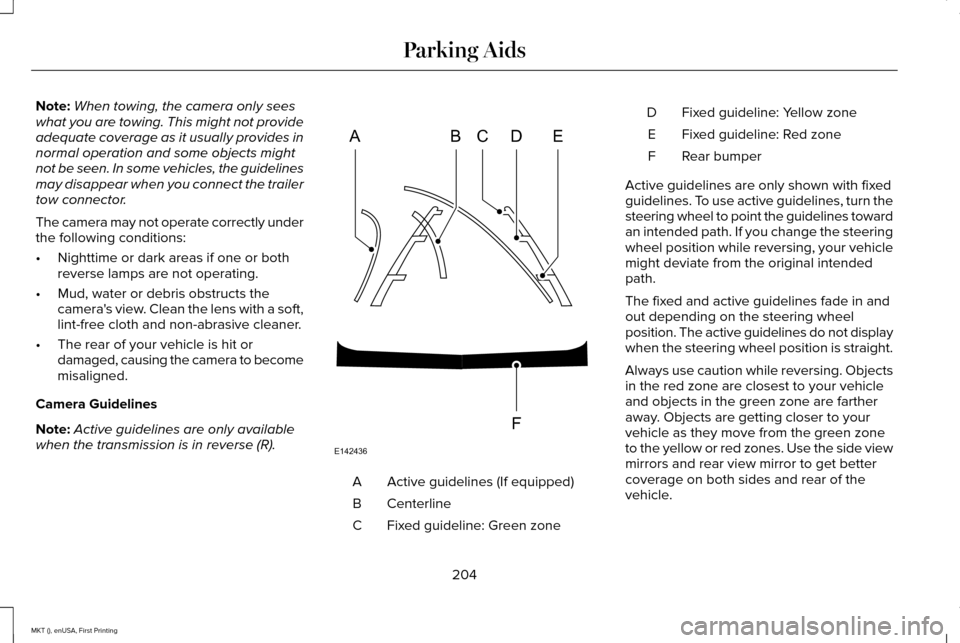
Note:
When towing, the camera only sees
what you are towing. This might not provide
adequate coverage as it usually provides in
normal operation and some objects might
not be seen. In some vehicles, the guidelines
may disappear when you connect the trailer
tow connector.
The camera may not operate correctly under
the following conditions:
• Nighttime or dark areas if one or both
reverse lamps are not operating.
• Mud, water or debris obstructs the
camera's view. Clean the lens with a soft,
lint-free cloth and non-abrasive cleaner.
• The rear of your vehicle is hit or
damaged, causing the camera to become
misaligned.
Camera Guidelines
Note: Active guidelines are only available
when the transmission is in reverse (R). Active guidelines (If equipped)
A
Centerline
B
Fixed guideline: Green zone
C Fixed guideline: Yellow zone
D
Fixed guideline: Red zone
E
Rear bumper
F
Active guidelines are only shown with fixed
guidelines. To use active guidelines, turn the
steering wheel to point the guidelines toward
an intended path. If you change the steering
wheel position while reversing, your vehicle
might deviate from the original intended
path.
The fixed and active guidelines fade in and
out depending on the steering wheel
position. The active guidelines do not display
when the steering wheel position is straight.
Always use caution while reversing. Objects
in the red zone are closest to your vehicle
and objects in the green zone are farther
away. Objects are getting closer to your
vehicle as they move from the green zone
to the yellow or red zones. Use the side view
mirrors and rear view mirror to get better
coverage on both sides and rear of the
vehicle.
204
MKT (), enUSA, First Printing Parking AidsABCD
F
E
E142436
Page 210 of 452
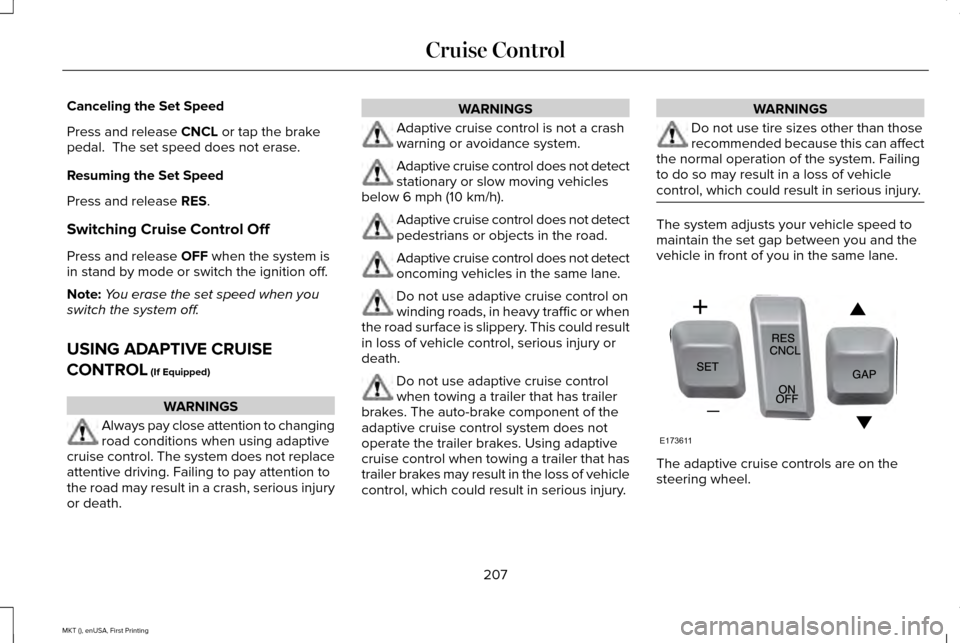
Canceling the Set Speed
Press and release CNCL or tap the brake
pedal. The set speed does not erase.
Resuming the Set Speed
Press and release
RES.
Switching Cruise Control Off
Press and release
OFF when the system is
in stand by mode or switch the ignition off.
Note: You erase the set speed when you
switch the system off.
USING ADAPTIVE CRUISE
CONTROL
(If Equipped) WARNINGS
Always pay close attention to changing
road conditions when using adaptive
cruise control. The system does not replace
attentive driving. Failing to pay attention to
the road may result in a crash, serious injury
or death. WARNINGS
Adaptive cruise control is not a crash
warning or avoidance system.
Adaptive cruise control does not detect
stationary or slow moving vehicles
below
6 mph (10 km/h). Adaptive cruise control does not detect
pedestrians or objects in the road.
Adaptive cruise control does not detect
oncoming vehicles in the same lane.
Do not use adaptive cruise control on
winding roads, in heavy traffic or when
the road surface is slippery. This could result
in loss of vehicle control, serious injury or
death. Do not use adaptive cruise control
when towing a trailer that has trailer
brakes. The auto-brake component of the
adaptive cruise control system does not
operate the trailer brakes. Using adaptive
cruise control when towing a trailer that has
trailer brakes may result in the loss of vehicle
control, which could result in serious injury. WARNINGS
Do not use tire sizes other than those
recommended because this can affect
the normal operation of the system. Failing
to do so may result in a loss of vehicle
control, which could result in serious injury. The system adjusts your vehicle speed to
maintain the set gap between you and the
vehicle in front of you in the same lane.
The adaptive cruise controls are on the
steering wheel.
207
MKT (), enUSA, First Printing Cruise ControlE173611